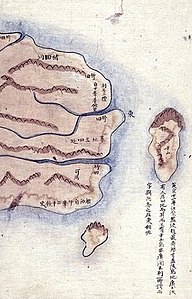| Usan | |
| Hangul | 우산국 |
|---|---|
| Hanja | 于山國 |
| Revised Romanization | Usan-guk |
| McCune–Reischauer | Usan-guk |

In 512, Usan-guk(于山國)was Ulleungdo(鬱陵島)
Usan-guk, or the State of Usan, occupied Ulleung-do and the adjacent islands during the Korean Three Kingdoms period. According to the Samguk Sagi, it was conquered by the Silla general Kim Isabu in 512.[1] He is said to have used wooden lions or tigers to intimidate the residents into surrendering. It has been written that the alias of Usan-guk is Ulleung-do. Usan-guk rarely entered into historical records, but appears to have continued a largely autonomous existence until its loss of independence to Goryeo in 930.[2][3]
History[edit]
Legend from Ulleung[edit]
A legend from Ulleung island tells a story of King Woohae (于海王), who was so strong that he invaded Tsushima Island to exterminate Japanese pirates. When King Woohae tried to go back, the king of Tsushima threw a huge party for Woohae and suggested an amicable diplomatic relationship between the two countries, and asked Woohae to marry his third daughter Pungminyeo (豊美女), who was beautiful. Pung became the Empress of Usan, and after this event, Usan began to fall in decadence, and Usan fell in a few years.[4]
Historical records[edit]
Earliest records that appear in the Records of the Three Kingdoms indirectly attest the existence of the kingdom, which says "When Wang Qi(王頎) (of Cao Wei) has come to Okjeo to conquer gung (Dongcheon of Goguryeo), he asked a local man whether there are people living in the east sea, and the man replied there are people living in an island that exists in the eastern seas, and they select a girl to put in the ocean every July."[5]
In Samguk Sagi, it is said that because of general Isabu's threats with wooden lions, Usan chose to be a vassal state to Silla in 512.[6]
In Goryeosa, it is recorded that Usan requested to be submitted under the rule of Goryeo in 930 by sending Baekgil and Todu.[7] In 1018, when Usan was severely affected by Jurchen invasions, the Goryeo king sent Lee Won Gu with farming equipment, and asked the locals of Usan who have fled from those invasions to return to their lands.[8] Usan was finally abolished and fully incorporated in 1022 as all the refugees from Usan was settled to the region of Yeju.[8]
Old Korean maps[edit]
- Usan
-
Joseon map (1530): Ulleungdo (鬱陵島) and Usan (于山島)
-
廣輿圖 (Gwang Yeodo,1737-1776)
This map showed Ulleungdo with a small island off its eastern shore labeled as "the so-called Usando" (所謂 于山島). -
Kim Jeong-ho "Daedongyeojido" (1861): East of Ulleungdo (鬱陵島) and Usando (于山)
-
A map by Korean Empire: Ulleungdo (鬱陵島) and Usan (于山)
References[edit]
- ^ "General Isabu of Silla Kingdom Incorporated Dokdo into Korean History". KBS World. December 29, 2011. Retrieved 12 March 2024.
- ^ The Alleged Title over the Island of Takeshima Invoked by the Republic of Korea jiia.or.jp Retrieved 28 July 2023
- ^ "The National Assembly of the Republic of Korea".
- ^ "「우해왕과 풍미녀의 전설」". 디지털울릉문화대전.
- ^ Records of the Three Kingdoms, Book 30
- ^ Samguk Sagi, Book4
- ^ Goryeosa, Book 1
- ^ a b Goryeosa, Book4



